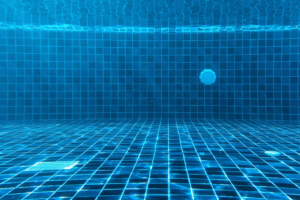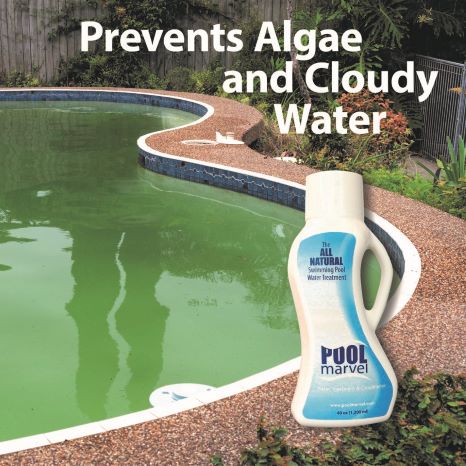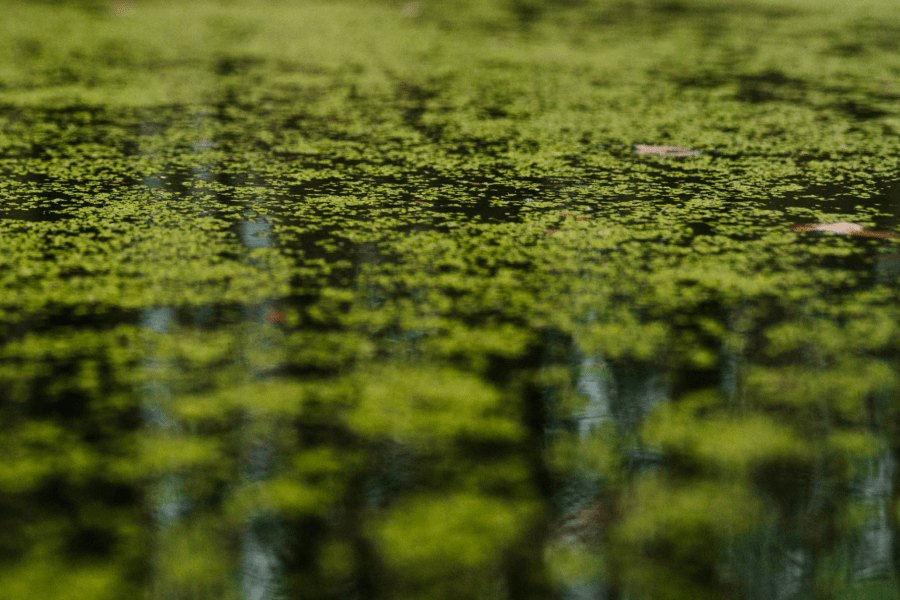
Green Pool Water
Green pool water is caused by algae, a large, assorted group of aquatic organisms that thrive in warm, humid temperatures. Algae produce oxygen through photosynthesis and reproduce through their own spores.
In a matter of hours, swimming pool algae can quickly multiply and create an infestation in pool water known as an algae bloom. Some algae – like green algae – are more common than others, but all algae can affect pool water quality and pose health risks to swimmers.
With the proper method and products, treating a green pool is possible. But because of a large algae bloom’s ability to easily reoccur, preventing pool algae in the first place is best.
What Causes Pool Algae?
Algae spores constantly enter your pool water via wind, rain, contaminated clothing, and contaminated pool cleaning tools. When the right opportunity presents itself, explosive algae growth occurs. Optimal conditions for an algae bloom include:
Poor Water Balance
Improper pH, alkalinity, cyanuric, and calcium levels can create the perfect environment for pool algae to populate. When low chlorine levels partner with water that’s too alkaline and has a high pH, algae can quickly grow.
Poor Water Circulation
Pool water consistently moves from the pool into the filter and then back into the pool. Having low flow or dead spots in your pool creates a build-up of foreign matter and generates algae growth.
Poor Water Filtration
Pool water needs to be filtered regularly. When a pool filter isn’t cleaned, it can no longer effectively trap contaminants and remove them from the water. Using the wrong-sized filter or having short filter run times can also cause algae to develop.
Poor Water Sanitation
Low or inconsistent chlorine levels can lead to an algae bloom in the pool, turning pool water green.
Common Types of Pool Algae
Algae exhibit different colour variations due to the photosynthetic pigments they contain. There are thousands of known algae varieties, with three of them commonly causing problems in swimming pools.
Green Pool Algae
After beginning as slight cloudiness in the pool, green algae continue to grow and impact water quality. Eventually, water clarity can deteriorate to the point that you can no longer see the bottom of your pool. Poor sanitation or circulation is usually the reason for green algae in pools.
Green algae can thicken so much that it suspends itself in the water and makes pool water murky. Besides free-floating, green algae can cling to walls, appear as spots on surfaces, cover large wall sections, or populate an entire pool with green slime. These algae can make pool floors and walls slippery and create green pool water.
Although it’s one of the most common types found in swimming pools, green algae are also the easiest to treat and prevent. High doses of chlorine and an algaecide can usually quickly eradicate the problem if your pool water is greenish.
Black Pool Algae
Black algae are more commonly found in cracks and crevices or areas where pool water doesn’t circulate well. While working its way deep into the surface, black algae can create permanent staining on the walls and filter. These algae appear as dark black or blue/green spots and can be as small as a pencil eraser tip or as large as a quarter. Because they prefer rough surfaces to grab onto, black algae are more commonplace in concrete or plaster-finished pools.
Black algae can form a protective layer over itself, making it a particularly tough type of algae to treat with standard chemicals. Completing treatment right away can help prevent these algae from burrowing deeper and making them harder to eliminate. A pool algaecide, chlorine tablets, or a stiff brushing should work for minor infestations.
More extreme cases of black algae may require the pool to be completely drained and cleaned by a qualified professional.
Yellow or Mustard Pool Algae
Yellow algae (also known as mustard algae) is wall-clinging and the most challenging algae to remove from pools. Rarer than green algae, yellow algae appear as yellowish-brown or dirt-coloured spots on the pool’s floor and walls, usually in shady areas. Sometimes, these algae are mistaken for green algae or pollen.
Yellow algae are sheet-forming and resistant to normal chlorine levels, with reinfection common. Like black algae, mustard pool algae can bloom even when there’s proper sanitization and filtration. This type of algae brushes off easily from surfaces but typically reappears in the exact location a few days later.
If mustard algae are present in a pool, an algaecide or chlorine enhancer targeting yellow algae is necessary.
How To Prevent Pool Algae
Preventing pool algae is easier to do than fixing green pool water. When there have been algae in your pool water in the past, it’s easier for future algae blooms to occur. Using the correct chemicals and practicing proper pool maintenance techniques can help keep algae at bay.
Maintain Proper Water Balance
Preventing pool algae starts by testing your pool water to see if it’s unbalanced. Every week, test and balance your pool water to meet the following ideal ranges:
pH: 7.4-7.6
Alkalinity: 80-150 parts per million (ppm)
Hardness, Calcium: 200-400 ppm
Cyanuric Acid (Chlorine Stabilizer): 30-50
Your free chlorine level is one of the most critical levels to note. You should maintain a consistent daily chlorine level of 2-4 ppm. If your chlorine level is inconsistent or too low, algae can grow.
If your pool water is unbalanced, first balance the water, and then add supplemental sanitizers and appropriate chlorine to restore proper levels.
Maintain Proper Water Circulation
Operate your pool filter for a minimum of 8 hours per day and possibly more on hot, sunny days. If the pool filter is undersized or the filter sand or cartridge is old, run it for even longer. Algae requires still water to grow, so it’s best to keep the water circulating, especially in larger pools.
Aiming the return jets accurately helps with water circulation and avoids creating dead spots, or breeding grounds for algae.
Maintain Proper Water Filtration
Inspect your filtration system weekly to ensure it’s working correctly, and clean your filter thoroughly using a pool filter cleaner. Although a filter cleaner won’t kill algae directly, it can help your filter stop particles that become algae food and trap algae itself. If a filter isn’t clean, foreign matter can accumulate and contribute to an algae bloom in pool water.
Be sure to complete a proper cleaning of your pool filter. If you only rinse your cartridge filter, particles may slowly release into your pool, possibly creating an algae outbreak. For sand filters, backwash the filter for three to five minutes to remove any remaining debris.
Maintain Proper Water Sanitation
Weekly, shock your pool to remove any contaminants that create the ideal environment for an algae bloom. The amount of shock you require will depend on your pool size and the type of shock product. After shocking your pool, add a preventative dose of a good quality algaecide to kill algae and help prevent future growth.
Use a Pool Water Conditioner
Add a pool water conditioner like Pool Marvel to your pool maintenance routine. This enzyme water treatment product helps to naturally prevent algae growth by eliminating the nutrients necessary for algae and bacteria to live. Chlorine will work more efficiently, resulting in less chlorine needed to maintain desired levels.
Other Algae Prevention Tips
Other methods for preventing pool algae include:
- Use a clean pool cover as a barrier to prevent algae and algae nourishment such as leaves, bugs, and dirt from entering your pool.
- Perform regular vacuuming and brushing of pool surfaces (walls, floors, and steps) to disrupt algae.
- Clean your pump baskets and skimmer regularly to minimize the opportunity for algae to bloom.
- Use an automatic pool cleaner to help maintain appropriate circulation.
- Thoroughly clean any toys or swimwear that have been in natural bodies of water before allowing them into your pool. This helps prevent the transfer of algae.
How To Get Rid of Pool Algae
The sooner you begin cleaning algae from your pool, the easier the process will be. Determining how to remove algae from your pool starts by identifying the type of pool algae present.
Green algae are best eliminated with shocking, whereas mustard algae in pools need both a good brushing and shocking. To kill black algae, a detailed brushing must take place to break open the protective layer before applying an aggressive shock treatment.
The following steps outline effective pool algae treatment for all types of pool algae.
Step #1: Clean Pool Water and Surfaces
If your pool has turned green, start by skimming as much visible debris, mould, and algae as possible.
Because algae are made up of microscopic particles, many of them will fall directly through the mesh. Using a steel bristled brush on a plaster pool or a nylon brush on a vinyl pool, remove algae from the walls and surfaces to get them into submersion. Otherwise, chemicals will not be as effective.
Focus on the worst areas for algae growth first, such as corners and other shaded areas. Pay special attention to areas with dead spots or locations with poor water circulation. Apply chlorine directly to the discolouration to remove algae stains from pool walls and steps.
Vacuuming pool algae is best done manually since automated or robotic pool cleaners can easily miss certain areas. As you stir up the algae, the pool water will become more and more cloudy. Set the multiport system to waste before vacuuming so that the debris bypasses the filter.
Step #2: Test and Balance Your Water
Test your pool water using test strips, a digital kit, or a liquid test. Balance your water chemistry properly so that your sanitizer will work effectively against the algae.
Step #3: Inspect Your Pool System
Check that your filter and pump are operating correctly. If you have a pool heater, turn it off to lower the water temperature. To increase water circulation, adjust pump valves and keep the pump constantly operating until the pool clears.
Step #4: Apply a Shock Treatment
Lowering the pool water pH to below 7.0 (or until it becomes acidic) will help chlorine be especially effective. Once done, add chlorine shock to complete the shock treatment. A pool shock helps eliminate contaminants that may cause an algae bloom and improves water filtration.
If there’s a lot of green algae in your pool, you’ll need more shock. To learn how to shock a green pool, use the package instructions to determine the recommended dose for your pool size. One pound of shock treats up to 10,000 gallons of pool water. Light green pool water will need a double shock, so add two pounds of shock for every 10,000 gallons. Dark green pool water requires triple shocking, or three pounds of shock for every 10,000 gallons. For black algae, quadruple shock your pool by adding four pounds of shock to every 10,000 gallons of water.
Avoid using stabilized chlorine due to the risk of creating an excess of cyanuric acid, and instead, consider using hypochlorite shock. Shock your pool at dusk or night. Leave your pool cleaning equipment in the shallow end so that it becomes sanitized by the treatment, too.
Keep your pool filter running for at least eight hours to circulate the shock effectively. Usually, a shock treatment will work almost immediately in a pool that’s turned green. If pool water is green even after shocking, repeat the brushing and shocking process.
If pool water is still greenish, the cause could be a malfunctioning pool pump, dirty filter, or imbalanced water chemistry.
Step #5: Apply an Algaecide
Certain types of algae may require the addition of specific chemicals, such as an algaecide. These products are specifically formulated to treat green, mustard, or black algae in pools. Algaecides are highly effective for early-stage algae growth, small amounts of algae, or as a preventative measure, but should only be used after the chlorine level drops below five ppm.
To know how much algaecide to put in a pool, follow the manufacturer’s directions on the algaecide bottle. Typically, it takes five to seven days for algaecide to work. Consult the manufacturer’s guidelines to know how long you need to wait to swim after adding algaecide to your pool.
Following an algaecide treatment, thoroughly brush your pool’s surfaces to remove any dead algae.
Step #6: Re-Test Your Pool Water
Test your alkalinity, pH, calcium, cyanuric acid, and chlorine levels again. Make any adjustments necessary before allowing swimmers to enter your pool.
Step #7: Clean Filter
Follow your owner’s manual to properly backwash or chemically clean your filter and remove any build-up of dead algae, organic contaminants, and minerals.
Run your pool’s filter and pump constantly for 24 hours. Doing so provides enough time for your entire pool’s contents to run through your clean filter.

Using a Flocculant To Get Rid of Pool Algae
Using a flocculant is an excellent option if you have limited time to remove algae from your pool.
Flocking agents coagulate tiny algae particles to sink to the bottom of a pool. Once that happens, the algae can then be easily vacuumed. Although flocculants work really quickly, they require more manual work than applying a shock treatment.
Start by raising the water level in your pool since a lot of water will be removed by vacuuming. Dilute the floc by following the package instructions, then pour it near the pool’s walls for maximum effectiveness. Allow it to circulate for about two hours. Shut your pump off and wait for the algae clumps to form on the pool floor.
Select the waste setting in your pool filter and connect your manual vacuum. If there isn’t a multiport valve, open your filter’s drain port to allow water to exit as you vacuum. When the vacuuming creates too much cloudiness, take a break to allow the particles to resettle before vacuuming again. Move slowly, and repeat the process until all clumps are removed.
After vacuuming, add replacement water to your pool and then run your filter until the water is clear.


